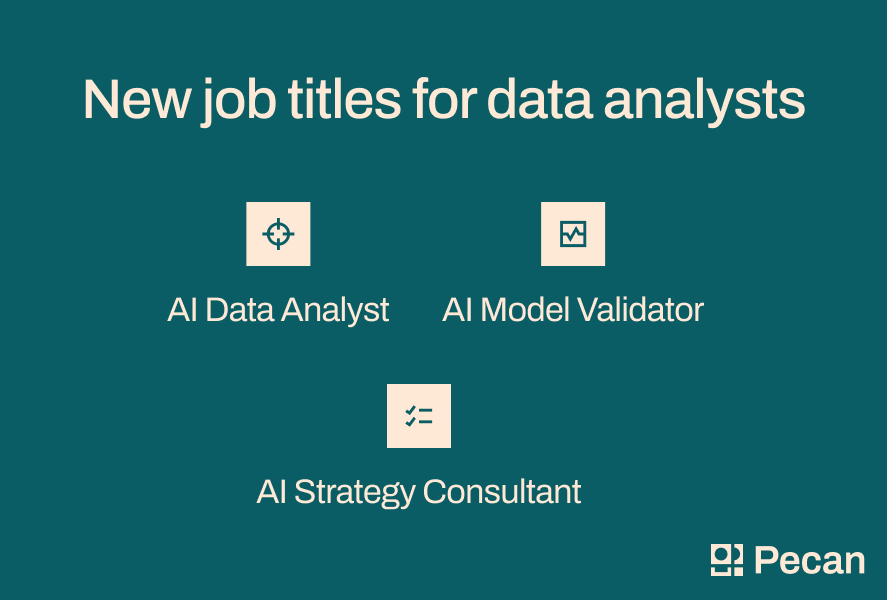- In a nutshell:Technological advancements have always raised concerns about job displacement, but historically, new job opportunities have emerged alongside these developments.
- Generative AI has the potential to automate certain aspects of data analysis, but it is unlikely to replace human creativity and strategic thinking.
- Instead of eliminating the role of data analysts, AI will enhance their capabilities and allow them to focus on higher-value tasks.
- To stay relevant as a data analyst, it's important to embrace AI, stay up to date on AI technologies, enhance proficiency in AI-related skills, and learn how to use AI tools effectively.
- The future of AI in data analysis depends on how analysts adapt and leverage its potential, with organizations increasingly shifting towards automation and AI-driven insights.
Throughout human history, technological advancement has always been met with a degree of caution. Whether there are concerns about personal privacy, environmental impact, public health, or even humanity's very future, some caution is certainly warranted. One concern has always existed is how technological development may affect the job market. This worry is almost as old as technology itself—just imagine how all those ancient Greek laborers felt when the pulley system was invented. The reality? Fears of job displacement are not unfounded, since technology has indeed led to the elimination of certain jobs. But rather than mass layoffs, the overall impact has been a gradual shift in the composition of the workforce. New job opportunities have consistently opened up alongside these developments—ones that typically require higher levels of education, skill, and creativity. Ultimately, this has generated a more productive and innovative economy. Here are some examples from specific industries:
- Printers and typesetters
- Replaced or impacted by: Word processing, digital publishing, and desktop publishing software
- New opportunities created: Content writers, graphic designers, UX designers, digital marketers, web developers
- Typists and transcriptionists
- Replaced or impacted by: Speech-to-text software, advanced typing technologies
- New opportunities created: Software engineers, AI trainers specializing in optimizing speech recognition systems
- Bank tellers
- Replaced or impacted by: Online banking, mobile banking applications, ATMs
- New opportunities created: Fintech specialists, data analysts in the banking sector, tech professionals leveraging data to provide personalized financial services
- Workers in manufacturing and agriculture
- Disrupted by: Advances in robotics and automation
- Robotics engineers, automation specialists, data analysts working on optimizing and analyzing production processes
- Travel agents:
- Disrupted by: Online travel-booking platforms, AI-powered chatbots
- New opportunities created: Travel technology professionals leveraging AI and data to personalize and enhance travel experiences
The question is: should we expect this trend to continue with the emergence of generative AI? Specifically, can AI fully replace BI analysts, engineers, and managers? And what does artificial intelligence mean for the future of data analysis? AI is already impacting data analysts and scientists, providing significant value, but to answer those questions, we’ll need to take a more nuanced look at the issue.
👉 Check out The Data Analyst 2.0, our in-depth guide to this rapidly changing role
Will AI replace data analysts?
Generative AI refers to AI-based systems that are capable of generating original content, such as text, images, and even video. This technology holds limitless potential for all sorts of applications and fields, and since the release of ChatGPT and DALL-E in 2022, along with hundreds of other AI-based tools to hit the market, generative AI has gone mainstream. Hundreds of millions of people—from marketers to software developers to salespeople to data scientists—have rapidly adopted this technology and begun to leverage it in their work. The expectation is that tools like ChatGPT and the models they are built on will keep improving to a point where they can automate and execute creative work, such as content writing, design, media production, and even coding, at an extremely high level. And yes, this “creative work” includes many of the tasks that are performed by data analysts, such as data preprocessing and cleaning, exploratory data analysis, statistical analysis, data visualization, and report generation. But will AI actually replace analysts? Here’s our take on it: While generative AI has the capability to automate certain aspects of data-related work, it’s unlikely to replace human creativity, strategic thinking, and the need for a human touch. Instead, it will continue to evolve as a tool that enhances our capabilities and productivity.
https://youtu.be/HL9jazedOVY?si=7HogNHGHC4sv_I5z[/embed]
▶️ Find out why our CEO and co-founder, Zohar Bronfman, thinks data and business analysts are actually the future of predictive analytics.
Yes, it’s becoming clear that certain parts of the analyst’s role will be replaced by AI. But many other parts will instead be enhanced or optimized, thus allowing analysts to do higher-quality work in less time. This will free up time and energy so they can focus on more complex and strategic initiatives, from developing business use cases, to communicating insights to stakeholders, to implementing data-driven business practices – tasks that are often overlooked or deprioritized as analysts work frantically to complete the more laborious parts of their job.
👉 Dive deeper into predictive analytics with our accessible guide, The What and Why of Predictive Analytics
Here are some examples of tasks that can be automated, and how they can help you achieve better results:
- Routine tasks (e.g., data cleaning and preprocessing, basic statistical analysis): Can focus on higher-value tasks that require critical thinking and domain expertise.
- Data visualization and reporting: Can spend less time on manual report creation and more time on interpreting results and providing strategic recommendations.
- Predictive analytics and forecasting: Expands the role of data analysts, enabling them to provide valuable predictive insights for strategic planning.
As we expect to be the case in most professional domains, generative AI is unlikely to eliminate the role of data analysts. Instead, it will amplify what they’re already able to achieve.
https://youtu.be/tVqL4MCxN7Y?si=YOokwqeOYBj0nIV-[/embed]
▶️ Get tips on how to improve your communication with business stakeholders as a data analyst in this video from Pecan's Zohar Bronfman.
Moreover, just as new technologies have historically led to the creation of new jobs, we expect that generative AI will contribute to the emergence of novel job opportunities designed to harness this technology. Such roles may include titles like “AI Data Analyst,” “AI Model Validator,” and “AI Strategy Consultant.” Indeed, this process has already begun.
Data analysts' job titles could look different in the near future due to AI.[/caption]
5 tips to help you stay relevant as a data analyst
If you hope to stay current as a data analyst in the coming years, you’ll need to embrace and actively incorporate AI into your work processes. Doing so will enhance your skills and capabilities, enable you to deliver more powerful insights, and position you as a relevant and valuable contributor to your organization. Here are five things you can start doing right away:
- Stay up to date on the latest AI technologies, algorithms, and trends that are relevant to data analysis. Get up to speed on topics like machine learning, natural language processing, and automated analytics. You can start by enrolling in an online course (like this one from Harvard University), attending webinars or in-person boot camps, joining relevant groups, following certain hashtags on LinkedIn, and checking out our Resource Center. There’s no shortage of information out there!
- Enhance your proficiency in skills related to AI. Upskilling in areas like machine learning, data mining, and programming languages commonly used in AI development (like Python and R), will empower you to leverage AI in your data analysis workflows. A good way to start is by exploring some of the online courses out there (like this one on Udemy). By getting educated about the latest techniques in AI and data analysis, you’ll become a much more attractive asset to any organization. (It’s worth noting, of course, that by using an AutoML platform like Pecan, you can train ML models and generate AI-based predictions without the need for any of these specialized skills.)
- Learn how to use existing AI tools as a way to enhance your efficiency and creativity. Whether it’s a general tool like ChatGPT or a purpose-built tool for data analysis, they can help you automate certain tasks, enhance your analytics capabilities, and accelerate your ability to uncover insights. For tips on how to leverage ChatGPT as a data analyst, check out our recent article, “How ChatGPT Can Make You A Better Data Analyst.”
- Encourage a culture of experimentation on your team so everyone can learn from one another as you try to optimize business results. Here’s a great example of one company that was able to improve business forecasting by embracing an experimental approach to the deployment of machine learning models. And if you’re looking for tips on how to foster AI experimentation and collaboration on your own team, you should check out these four strategies for building a data-driven culture.
- Identify AI use cases, and regularly assess your processes to identify areas where AI can improve efficiency and add value. For example, you may adopt a predictive analytics platform as a way to minimize customer churn, predict upsell behavior, or forecast inventory demand. By focusing on specific use cases and how AI can help solve them, you can directly impact business KPIs, increase the value and accuracy of your analyses, and better communicate those insights. Not sure where to start? Check out the bottom of this linked article to see how to start building a business use case.
The future of artificial intelligence in data analysis
Ultimately, the impact of AI on the profession of data analysis will depend on how analysts adapt to this technology and leverage its potential. Individuals and organizations that take a proactive approach to stay up to date – for example, by focusing on upskilling and taking advantage of existing tools – will experience the greatest returns. One of the most impactful (and easiest) ways to get started is by tapping into the transformative power of predictive analytics. Predictive analytics uses advanced machine learning to find patterns in historical data, which can then be used to make highly accurate predictions about future business outcomes (as opposed to simple statistical observations of past behavior). This way, analysts can inform and drive key business decisions that create significant bottom-line impact. By using a predictive analytics platform powered by automated machine learning (AutoML), analysts can build and scale powerful predictive models – a feat previously only achievable by the most skilled data scientists and engineers. And they can do so in a matter of hours, not months. For these reasons and more, we believe that organizations will increasingly shift away from simple statistical modeling and outdated labor-intensive practices, towards the powerful automation and AI-driven insights of AutoML-based systems. By fully embracing the possibilities of generative AI and leveraging it as a tool for innovation, you can successfully navigate the changes it brings, and ensure the future job market continues to offer you challenging and rewarding career opportunities. Will AI replace data analysts? Not you! Seize the AI opportunity and unlock your career’s full potential. Start your journey with a free trial of Pecan’s predictive analytics platform.







